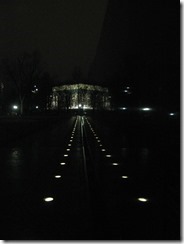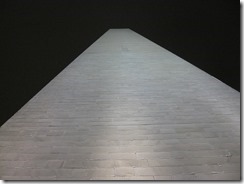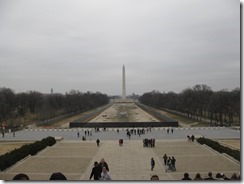Today is the 50th anniversary of the historic March on Washington. This post is a combination of photos and my encounters with racism in America.
My travels have taken me to Washington, D.C. in different periods of my life from 1973 to 2011. From 1990 to 1993 I frequently traveled to Washington as a member and elected representative for members of the National Education Association.
February 2011 I visited Washington, D.C. for a week to make a Loyalty Traveler survey of downtown D.C. chain hotels when I came down with the flu. I checked into an uncomfortably warm room at the InterContinental Willard. After a couple hours sleep I woke up in a sweat and since the window would not open to cool down the room, I went for a midnight walk on the National Mall. The photos in this post are from that late night walk.
Childhood impressions of segregation in Virginia
My first visit to Washington D.C. in 1973 was part of a 7th grade school field trip from Lee Hall Elementary School in Newport News, Virginia. Moving to Virginia soon after my 12th birthday for 18 months was my first significant exposure to institutionalized segregation.
My family lived in an apartment in Newport News for a few months while waiting for military housing availability on Fort Eustis Army Base. Behind our apartment complex was the invisible barrier dividing the town with black residents on one side.
The bus my sister and I rode to school came from the residential neighborhood east of the apartments where the black families lived. We were the only two students picked up by the public school bus at the apartment complex. And we were the only two students who were not black Americans to ride that bus. Newport News School District was under court-ordered desegregation.
Several of my new friends in my 6th grade class at Lee Hall Elementary, Newport News lived in a housing area called Stoneybrook. I was surprised to learn that I was not considered white enough to swim in the community pool. My skin was rather dark after a year living in the New Mexico desert.
Several of my play friends from 3rd grade through 6th grade were black children. Neighborhoods I had lived in on U.S. Army bases in Oklahoma, Germany and New Mexico were integrated housing with people of all races living together. I even had a girlfriend in New Mexico who was dark, but I assumed her skin was sun tanned dark like most of us kids living in the desert. To my surprise, the first time I went to her house for a meal it became evident she was from an African American family. That really did not matter to me.
After moving to Virginia, my new friend Darwin, a black boy in my class, was the only remaining passenger with me on the bus ride to Lee Hall Elementary after the high school students, including my sister, were dropped off. Darwin and I were the first kids to arrive at school and we played basketball every morning while waiting for other kids to arrive.
Black kids were not invited to our white classmate’s birthday party in Stoneybrook. I think it was probably somewhat scandalous that an Oriental and this Mexican (me) had been invited. I was told the Asian girl was not permitted in the community pool. I did not think at the time that I might be excluded too. I never tried to go swimming there since I had moved to Fort Eustis by summer time. Darwin definitely would not have been allowed in the community swimming pool at Stoneybrook.
The first black family purchased a house in Stoneybrook about the same time my family moved to Virginia in January 1972.
Elaine Wilson and her husband, Wesley, were the first blacks to buy a home in Stoneybrook in the early 1970s. She says the family received a cold reception, especially after Wesley Wilson filed a lawsuit against a neighborhood civic league that didn’t admit blacks.
Even though a cross was burned on their lawn and their young children were taunted on the school bus, Mrs. Wilson said, the family was determined to stick it out. Eventually she became good friends with several white women on her block, and they’re still close today.
Special Report: Neighborhoods In Black And White
Denbigh Subdivision Eases Into Racial Harmony
(Daily Press Aug 4, 1991)
1990 and Morris Dees of the Southern Poverty Law Center
I did not return to the Washington D.C. area until 1990 when I attended a speech by Morris Dees of the Southern Poverty Law Center at the Capital Hilton Hotel.
A landmark case against the White Aryan Resistance had been decided that week in October 1990 awarding $12.5 million to the family of Mulugeta Seraw, an Ethiopian college student murdered in 1988 by Skinheads in Portland, Oregon. The significance of the case was Tom Metzger, president of the White Aryan Resistance (WAR), was held accountable for the murder after WAR recruited and trained the Portland skinhead gang who committed the murder. In 1994 the U.S. Supreme Court refused to hear Tom Metzger’s appeal and the assets of WAR were sold to pay the judgment fine to Seraw’s family.
I don’t recall Morris Dees exact words from that speech, but I do recall tears streamed down my face as he told stories of violent racist attacks and the Southern Poverty Law Center’s fights for justice and elimination of racist organizations.
The struggle against racism continued in the 1990s. In 1992 I was driving the Golden Gate Bridge when I heard high school students had taken over the Bay Bridge and stopped traffic following the acquittal of the police officers in the Rodney King beating. I cheered nonviolent action as I drove in my car.
Later that night I sat in the Crowne Plaza SFO as Los Angeles and San Francisco and a dozen other cities across America burned in protests and riots. The dream of nonviolent protest over the verdict had turned into a nightmare of extreme terror with many innocent victims.
Lincoln Memorial
These days I live in Monterey, California in a town with fewer than 3% blacks. The adjacent town of Seaside was over 20% black residents when I attended Seaside high school in 1977. One of the most noticeable changes when I returned to the Monterey Peninsula in 2001 was Seaside looked like a city where few black families remained. The population has not really changed much in 35 years, however, the demographics have changed significantly with only about 8% black residents today.
Vietnam War Memorial looking to Lincoln Memorial.
I have many questions, few answers and disjointed memories of race in America and its impact on my life. I felt fortunate that most people I have met as an adult assumed my surname was Italian, not Spanish. My skin is light enough that most people assume I am a plain white guy.
Looking up at the Washington Monument.
There are no great revelations to share with readers in this post.
I just felt like I needed to commemorate this date and the anniversary of the March on Washington in 1963. I believe we still have a long way to go to build the American dream of plurality and economic opportunity for all, regardless of the color of your skin.
View from the Lincoln Memorial of the Reflecting Pool without water in February 2011.
Related Link: 50th Anniversary March on Washington
Ric Garrido, writer and owner of Loyalty Traveler, shares news and views on hotels, hotel loyalty programs and vacation destinations for frequent guests.
Follow Loyalty Traveler on Twitter and Facebook and RSS feed or subscribe to a daily email newsletter on the upper left side of this page.









4 Comments
Comments are closed.